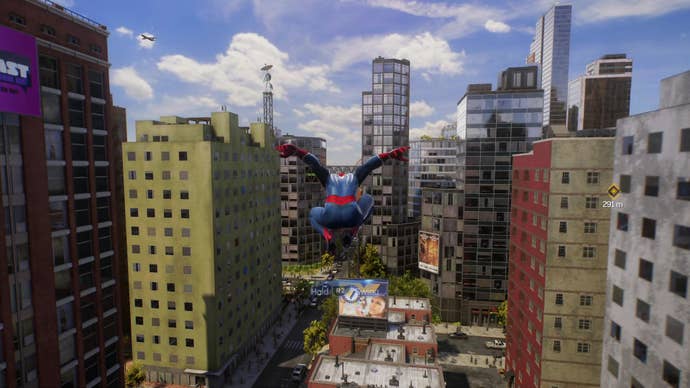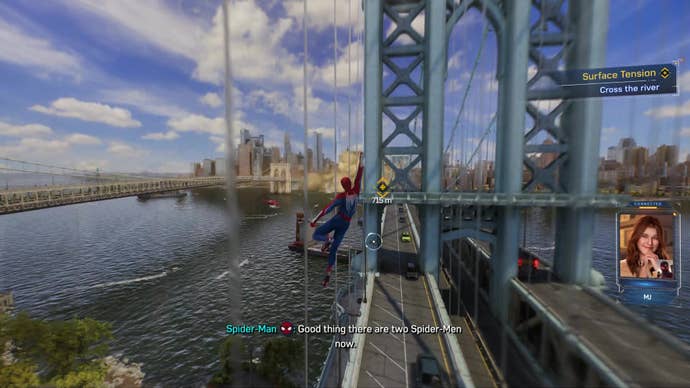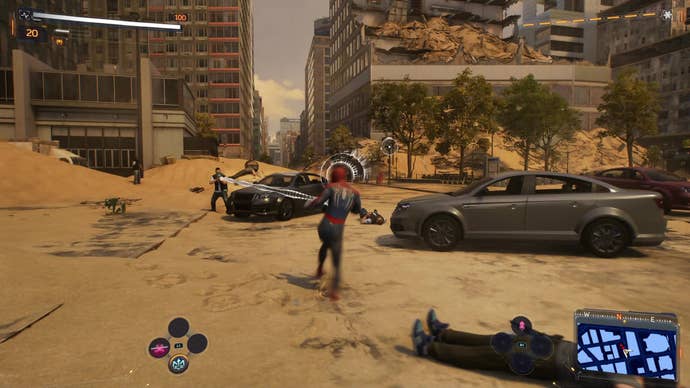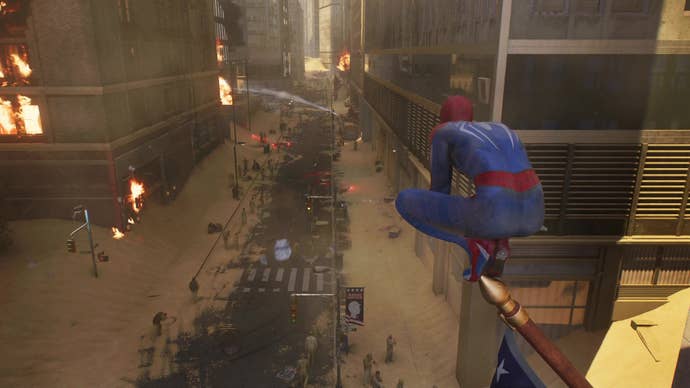New to the world of Marvel’s Spider-Man, or just in need of a quick refresher before jumping into Marvel’s Spider-Man 2? From traversing New York City to dealing with hoards of baddies single-handed, there’s a lot to get to grips with in the world of Spider-Man 2.
Having spent a good few hours with the game now, here are the top ten things we wish we’d known before getting started with the sequel.
Spider-Man 2 guides
Spider-Man 2 tips & tricks for beginners
Get into the swing of things early on
If you haven’t played either the original Marvel’s Spider-Man or the interquel game Spider-Man: Miles Morales — or if it’s just been a while since you did — it’s a good idea to have a practice swing around New York at your earliest convenience. There’s a delightful flow to traversal in these games, but Spider-Man 2 does sort of assume that you’re a returning player and basic tutorials are accordingly light, so there’s really no substitute for a bit of hands-on practice.
You can also adjust swing assist within the game’s extensive accessibility settings, which can be a huge help if you’re out to get more momentum or speed to tailor your web-swinging experience to what feels best for you.

Burrow through those Boroughs
One feature from the original game that doesn’t make a return in Spider-Man 2 is the need to complete side-activities to uncover new areas of the map. Instead, the first time you swing through a region it’s enough to reveal the areas you crossed through on the map, which is much easier (and to be honest makes more sense; after all a huge theme of the game is that Peter and Miles are both New York City natives). Pins revealing the locations of side activities, photo opportunities, etc. also have quite a generous tendency to auto-populate if you’ve been anywhere in their broad vicinity.
On a possibly related note, fast travel doesn’t open up nearly as early as it did in previous games — it’s now a district-by-district reward you’ll only unlock once you’ve got about 50% of the way through doing everything in a given region. (We’ve also lost those funny fast-travel vignettes of Spider-Man riding the subway, presumably because they were there to cover load times that don’t exist any more on the PS5.) This means that you’ll need to take the scenic route for much of the game — but that feeds neatly into the task of opening up the map.
Do air tricks while swinging for a small but welcome XP boost
While swinging through New York City, you can perform air tricks by pressing ‘Square’, and change your trick style using the directional input on the sticks. Not only does this look very cool and add a bit of extra fun to your longer journeys across the map, but you get a small but welcome hit of XP for every trick you complete. It might not look like much at first, but it all adds up, so if you’re right on the cusp of levelling up it can be well worth spending a minute or two goofing around to unlock that next sweet, sweet skill point.
There’s also a trophy (“Splat!”) awarded the first time you stack it by failing to pull out of an air trick too late and hit the ground (or indeed a building, or any other obstacle). Good job Spider-Men don’t take fall damage, so all that’ll be hurt is your pride, and at least the trophy can help with that.
You can waterski to make traversing the river less arduous
Thanks to the addition of Queens and Brooklyn to the series’ explorable regions, the expanded map in Spider-Man 2 is now bisected by a vast stretch of the East River. This means that until you’ve unlocked fast travel, you’ll need to figure out a way across the water when the story calls for you to cross the river.
It is possible to web swing across bridges (pro tip: it’s easiest if you stick to the underside), but said bridges aren’t always necessarily in the best location to get you from Point A to Point B. Happily, one new feature of Spider-Man 2 is the ability to waterski for short distances. When Spidey lands in the water, you can enjoy a few seconds of carefree surfing before pressing ‘Cross’ on the face buttons to launch into another jump, allowing you to repeat the process again upon landing.

Complete side missions and activities as you go…
Given that Spider-Man 2’s open world can look intimidatingly full at first, you might be tempted to beeline through the main story for a while and then go back to mop up what’s left if and when you feel like it. However, Spider-Man 2 is well-designed to ensure that your ideal route through the game includes regular pit-stops to engage in side-stories. For example, quite early on you’ll find yourself in need of some Hero Tokens to unlock the next level of one of your most useful gadgets — and Hero Tokens can only be obtained by completing certain side missions.
So, if you don’t want to arrive in Spider-Man 2’s endgame underlevelled, make your peace with the fact that you’ll be doing pretty much everything in this game in the course of your first playthrough. But on the plus side, it bears repeating that this game is well-designed, with side missions and other activities unlocking at a point where it generally makes sense to dig into them before returning to the main story.
… But you can probably afford to skip some street crimes
Street crimes are still very much present in Spider-Man 2, but they carry a bit less weight than they did in the previous games. While you still get nice XP payouts for completing them and performing bonus feats within them, district progress is no longer tied directly to solving a certain number and type of street crimes in each region. So you can afford not to sidetrack yourself every time one of those red danger triangles pops up on your screen (and it does happen a lot).
However, I wouldn’t recommend ignoring street crimes entirely. Not only does the XP you’ll gain from solving them undoubtedly help, but they’re good practice for some of the tougher enemy bases you’ll encounter later in the game. Furthermore, swinging right by and ignoring a street crime doesn’t feel very Spider-Man, you know? Oh, and finally, there’s a chance that engaging in some impromptu crime fighting here and there will summon whichever Spidey you’re not playing as at the time to help out AI-style, which gives you access to some unique finishers and other funny moments as Peter and Miles team up against some bad guys.
Hold ‘Square’ to launch a single enemy upwards if you get surrounded
This is a trick players familiar with the other games in the Marvel’s Spider-Man series will already know, but it’s not tutorialised in any depth in Spider-Man 2, so it bears repeating. Approaching an enemy and holding down ‘Square’ on the face buttons will cause Spider-Man to punch them into the air, launching them above the action and allowing you to land a few more hits as they flail.
This is worth doing for a couple of reasons, but the best thing about it is the opportunity for crowd control. Early in the game and even at some points later on, you might find yourself getting overwhelmed if Spider-Man is surrounded by enemies. When this happens you’ll welcome the ability to focus on them one at a time, which is what the air launch power allows you to do. Later levels of the skill tree open up useful bonuses too, like the ability to recharge powers extra quickly by performing air launch combos.
Of course, separating an enemy from the crowd via an air launch only gets Spider-Man out of the way of melee attacks, which leads us neatly onto the next point…

Learn to dodge, even if you hate dodging
Look, I feel you. Dodging and/or parrying just isn’t everyone’s favourite part of an action game, and you might be someone who has a good line in just making their own way out of trouble by a tried-and-true combination of jumping, sprinting, or just tanking the hit. (Can you tell I’m speaking from experience here?)
However, Spider-Man 2’s good game design strikes again in that dodging and parrying are, if not strictly essential, then at least very useful to you. Spider-Man isn’t really built to tank, and taking relatively few hits can land your superhero in a surprising amount of trouble if they’re too close together. So you should always prioritise dodging — the need for which is indicated by the Spider-sense alert around Spidey’s head, which pops up when an enemy locks on and goes from white to red when a blow is about to land — above whatever else you had planned at that moment in combat. Heavy attacks from certain brute enemies also require a special heavy dodge, and unfortunately the only way to know what you’re about to be hit with is to keep an eye on who’s gearing up to attack you, so pay close attention!
There’s also a skill in the game that allows you to follow up a perfect dodge with a free blast from Spider-Man’s web shooter, slowing down the next counter-attack from the baddie whose hit you just avoided. In fact, a whole branch of the skill tree feeds off of your perfect dodges, granting the ability to do things like recharge your gadgets faster.
Learn to parry, even if you hate parrying
Spider-Man 2 adds a new parry mechanic to complement those returning Spider-sense-assisted dodges. Whilst dodging is essential in some boss fights, and blocking goes a long way against your regular hired goons, parrying is the new mechanic that steals the spotlight in Spider-Man 2. Why? Because it’s a great use of Spider-sense and melee together.
Timing the shoulder-button L1 press to an incoming enemy attack not only knocks them back, it can fill up your various gauges better and provide breathing space (especially handy when you’re being mobbed by brutes and regular enemies). Either following up with a launcher or using your few milliseconds of spare time to divert your attention elsewhere quickly becomes an important skill to have at your disposal – especially as you get deeper into the game and enemies become more aggressive, agile, and resistant.

Be patient and methodical during stealth sections
When faced with a large group of baddies, Spider-Man will often have the option to engage stealthily, at least to begin with, in order to thin out the herd before the superpowered punching begins. From a high-up perch point, Spider-Man can learn enemy patrol patterns and wait until an individual is isolated to perform a variety of stealthy takedowns, or cause noise distractions to split up groups for easier picking-off. During sections where you’re playing as Miles, you’ll also have access to a limited invisibility feature, allowing you to hop around in areas where you’d usually get seen.
The advice here is really just to take advantage of these stealth opportunities when they arise, since they usually crop up around a group of enemies which may be too large to take on all at once in an all-out battle. Plus it’s really funny to perform a perch takedown that leaves webbed-up baddies dangling in mid-air, although I do sometimes have to wonder whether bouncing their heads off steel girders to subdue them is really as “non-lethal” as Spidey likes to claim. But yes, the point is that stealth in Spider-Man 2 can be very rewarding, and there’s no need to rush when you find yourself in the position to work your way through a base of baddies one at a time.
… Unless you’re in the midst of one of the game’s POV switches that sees you take on forced stealth in the role of (shudder) a non-powered person, of course; in which case we recommend running, gunning, and when all else fails hiding until the heat dies down to get those sections over with as quickly as possible.
If you’re brand new to Marvel’s Spider-Man, you might like our beginners’ guide to 2018’s Marvel’s Spider-Man — it’s a lot like this guide, but without all the talk about new features added for the sequel. Have some more specific questions about how to unlock certain trophies in Spider-Man 2? Check out our guides to finding Aunt May’s grave and getting a homerun at the baseball stadium.
This post was originally published on this site be sure to check out more of their content.








